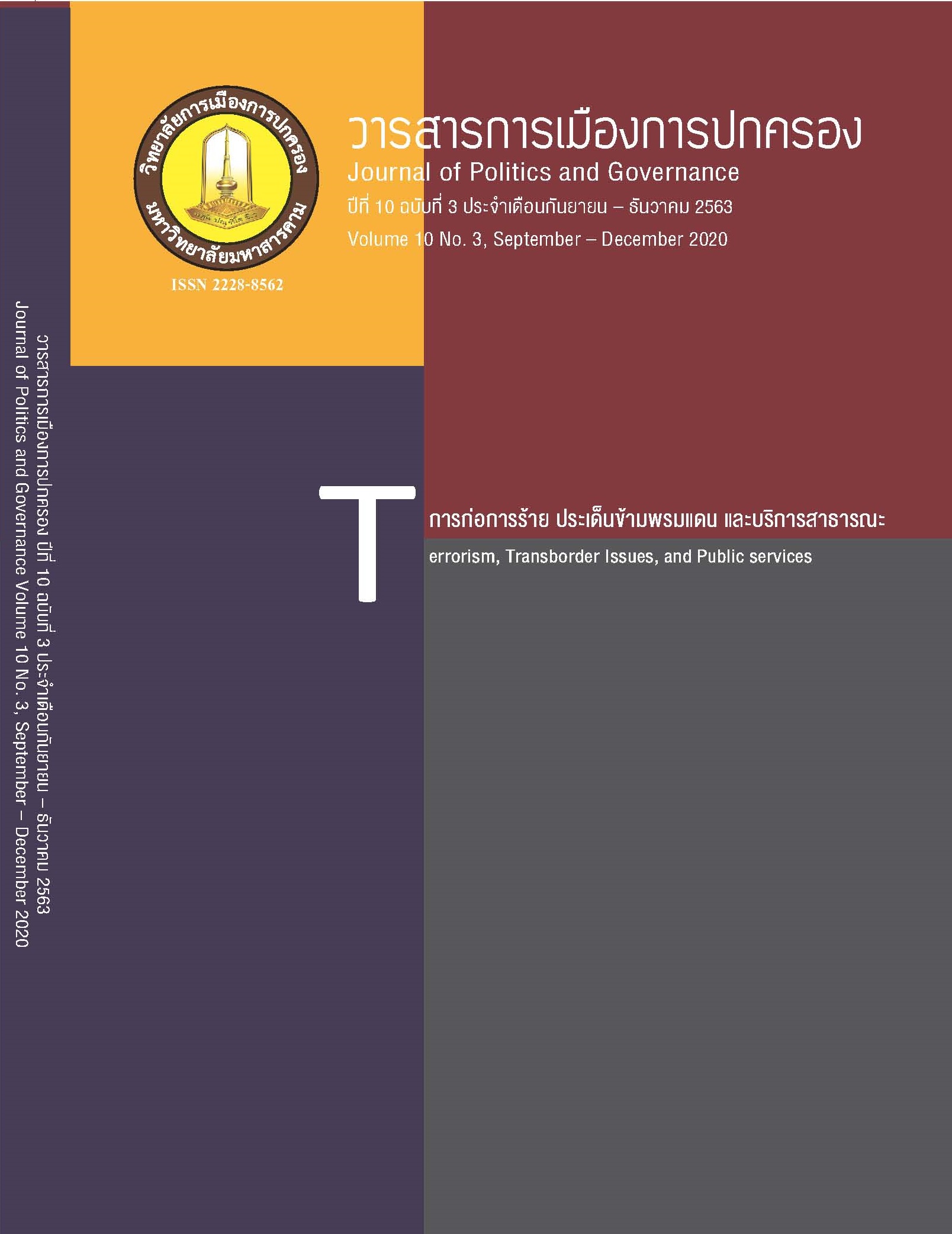Stripping the Cover: The Politics of the Thai Civics Textbook during 2007- 2016
Main Article Content
Abstract
“Stripping the Cover: The Politics of the Thai Civics Textbook during 2007- 2016” is an attempt to point out the significance of a “cover” of an textbook which is as important as the written content inside. This paper is based on the analytical approach of “the Rhetoric of the Images” by Roland Barthes with a “New Historicism” methodology as to study the textbook’s cover as an evidence of a cultural production at that time. The subject intends to discover the relationship between the encoded cultural values in the Thai civics textbooks and the national ideologies that the state promoted during the beginning of 2007 – 2016 decade. The result from this study has revealed that the Thai civics textbook’s covers have interpellated the cultural value that is consistent with the preserved state’s discursive ideologies of nation, religion, monarchy, Thainess, and the constitutional monarchy. The textbook’s cover is thus functioned as the reproduction of these ideologies and the masqueraded state’s propaganda. It is a devious political tool for the state’s discursive interpellation of these ideologies.
Article Details
References
ชาตรี ประกิตนนทการ. (2558). สถาปัตยกรรมไทยหลังรัฐประหาร 19 กันยา 49. กรุงเทพฯ: สำนักพิมพ์อ่าน.
ไชยันต์ ไชยพร. (2557). นิธิ เอียวศรีวงศ์ ใน/กับวิกฤตการเมืองไทย. กรุงเทพฯ: คบไฟ.
ณรงค์ พ่วงพิศ และวุฒิชัย มูลศิลป์. (2552). ประวัติศาสตร์ไทย. กรุงเทพฯ: อักษรเจริญทัศน์.
ณัทธนัทธ์ เลี่ยวไพโรจน์. (2552). หน้าที่พลเมือง วัฒนธรรม และการดำเนินชีวิตในสังคม. กรุงเทพมหานคร: สำนักพิมพ์สถาบันพัฒนาคุณภาพวิชาการ.
ธวัช ทันโตภาสและคณะ. (2552). หน้าที่พลเมือง วัฒนธรรม และการดำเนินชีวิตในสังคม. กรุงเทพมหานคร: สำนักพิมพ์วัฒนาพานิช.
นครินทร์ เมฆไตรรัตน์. (2535). การปฏิวัติสยาม พ.ศ. 2475. กรุงเทพฯ: มูลนิธิโครงการตำราสังคมศาสตร์และมนุษยศาสตร์.
นงลักษณ์ ทองอยู่. (2552). หน้าที่พลเมือง วัฒนธรรม และการดำเนินชีวิตในสังคม. กรุงเทพมหานคร: สำนักพิมพ์แม็ค.
นิธิ เอียวศรีวงศ์. (2557). ชาติไทย, เมืองไทย, แบบเรียนและอนุสาวรีย์ ว่าด้วย วัฒนธรรม รัฐ และรูปการจิตสำนึก. กรุงเทพฯ: มติชน.
มาลินี คุ้มสุภา. (2548). อนุสาวรีย์ประชาธิปไตยกับความหมายที่มองไม่เห็น. กรุงเทพ: วิภาษา.
วารุณี โอสถารมย์. (2524). การศึกษาในสังคมไทย พ.ศ. 2411- พ.ศ. 2475. วิทยานิพนธ์อักษรศาสตร์มหาบัณฑิต จุฬาลงกรณ์มหาวิทยาลัย.
วีรนุช สรารัตนกุล. (2552). หน้าที่พลเมือง วัฒนธรรม และการดำเนินชีวิตในสังคม. กรุงเทพมหานคร : สำนักพิมพ์ประสานมิตร.
สำนักงานคณะกรรมการการศึกษาขั้นพื้นฐาน กระทรวงศึกษาธิการ. (2553). หน้าที่พลเมือง วัฒนธรรม และการดำเนินชีวิตในสังคม. กรุงเทพมหานคร: โรงพิมพ์ สกสค. ลาดพร้าว.
Althusser, L., Balibar, E., Bidet, J., & Goshgarian, G. M. (2014). On the reproduction of capitalism: Ideology and ideological state apparatuses. London: Verso.
Anderson, B. (1983). Imagined Communities: Reflections on the Origins and Spread of Nationalism. London: Verso.
Barry, P. (2002). Beginning Theory: An Introduction to Literary and Cultural Theory. Second Edition. New York: Manchester University Press.
Barthes, R. (1977). "Rhetoric of the Image." in Image, Music, Text. Ed. and trans. Stephen Heath. New York: Hill and Wang.
Bhabha, H. (1990). Nation and Narration. London and New York: Routledge.
Bourdieu, P. (1999). “Rethinking the State: Genesis and Structure of the Bureaucratic Field” in George Steinmetz (ed.). State /Culture: State Formation after the Cultural Turn. Ithaca: Cornell University Press.
Foucault, M., (1975). Discipline and Punish: The Birth of the Prison. (trans. Alan Sheridan). New York: Pantheon Books.
Peirce, C. S., & Welby, V. (2001). Semiotic and significs: The correspondence between Charles S. Peirce and Victoria Lady Welby. Elsah, IL: Arisbe Associates.
Saussure. F.de (1960). Course in General Linguistics. London: Peter Owen.
Veeser, H.A. (1989). The New Historicism. New York: Routledge.


